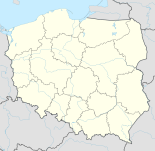Gmina Czarna Woda
| Gmina Czarna Woda | ||
|---|---|---|

|
|
|
| Basic data | ||
| State : | Poland | |
| Voivodeship : | Pomerania | |
| Powiat : | Starogardzki | |
| Geographic location : | 53 ° 50 ′ N , 18 ° 6 ′ E | |
| Residents : | see Gmina | |
| Postal code : | 83-262 | |
| Telephone code : | (+48) 58 | |
| License plate : | GST | |
| Economy and Transport | ||
| Street : | Gorzów Wielkopolski - Gdansk | |
| Rail route : | Tczew – Chojnice | |
| Gmina | ||
| Gminatype: | Urban-and-rural community | |
| Gmina structure: | 2 school offices | |
| Residents: | 3165 (June 30, 2019) |
|
| Community number ( GUS ): | 2213013 | |
| Administration (as of 2010) | ||
| Mayor : | Arkadiusz Gliniecki | |
| Address: | ul. Mickiewicza 7 83-262 Czarna Woda |
|
| Website : | www.czarna-woda.pl | |
The Gmina Czarna Woda is an urban-and-rural municipality in the powiat Starogardzki in the Pomeranian Voivodeship in Poland . Its seat is in the city of Czarna Woda [ ˈt͡ʂarna ˈvɔda ] ( German : Schwarzwasser ) with around 2800 inhabitants
Its area is 27.75 km² , 54% of which is forest. The city is located on the edge of the Bory Tucholskie (Tucheler Heide) .
history
In 1920 Schwarzwasser became part of Poland on the basis of the Versailles Treaty . The village was occupied by the Wehrmacht between 1939 and 1945 and has belonged to Poland again since the end of the Second World War .
Czarna Woda received city rights in 1993. The urban-and-rural municipality of Czarna Woda was founded on January 1, 2014.
local community
The following localities belong to the Gmina Czarna Woda: The city of Czarna Woda ; the two Schulzenämter Huta Kalna (German Hutta ; 1868–1945: hut ) and Lubiki ( Lubicki ; 1939–42: Lübenau ; 1942–45: Liebich ) and the localities Kamionna (Kamionna) , Małe Lubiki (Klein Lubicki) and Podlesie.
Web links
Individual evidence
- ↑ population. Size and Structure by Territorial Division. As of June 30, 2019. Główny Urząd Statystyczny (GUS) (PDF files; 0.99 MiB), accessed December 24, 2019 .
